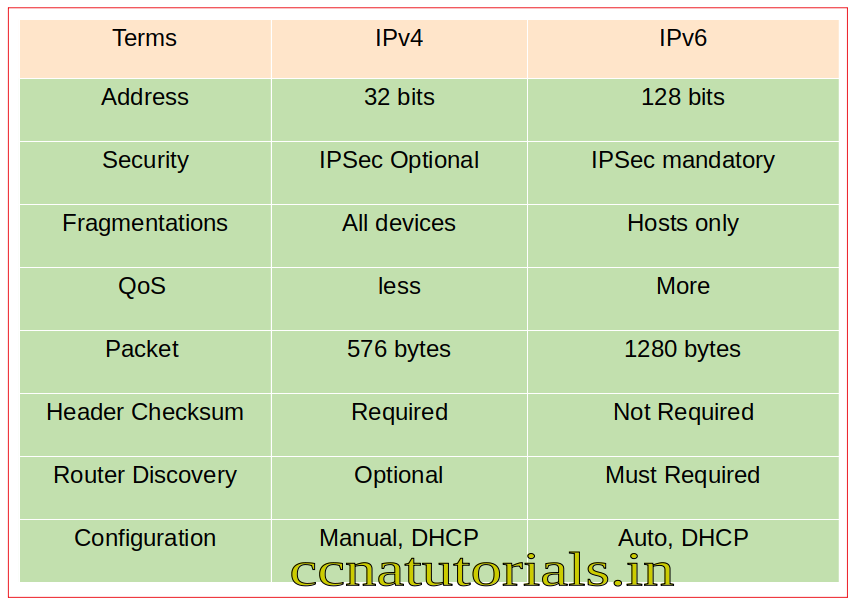Contents of this article
In this article i describe the Internet Protocol Version6 IPv6. It is also known as IP next generation or IPng. IP address is the identity of any device in a network. Without IP address any device can not communicate with the network or other devices. IP is acronym of Internet Protocol. In any network the devices are identify by its unique IP address.
IP protocol works on internet layer in TCP/IP model. IP address system created by fix length binary numbers. The IP address system in computer networking is a logical numeric address alloted to devices in the network. MAC address is the hardware address and never change in any network.
The IP address can be changes for each device in a network. IP system was designed to allow hosts to communication with each other. IP system is the identity of any hardware device for communication. The IP system is of two types IPV4 and IPV6. Here in this article we discuss about IPV6 only. There is a separate article for IPV4 on this website.
Before going to explain IP address system in computer networking. Some terms are necessary to know which are used in IP address system in computer networking. A Bit may be either 0 or 1. One Byte is equal to 8 bits. One Octat is equal to 8 bits and. Network Address is the designation used in routing protocols for sending the data. It is basically the first address of any subnet.
Network address never used by any device. Network address is the identity of any network. Broadcast Address is used to send data to all nodes in a network. Broadcast address is the last IP of any subnet. In any network Network address and Broadcast address never assigned to any device. For example 192.168.1.3/24 IP belongs to Network ID 192.168.1.0/24 and Broadcast ID is 192.168.1.255/24.
Internet Protocol Version6 IPv6 explained
Internet Protocol Version6 IPv6 is a type of internet protocol. We know about IPv4 and works with IPv4 for inter-networking and local networks. IPv4 address is a combination of 8 bytes or 32 bits. Every device connected in a network or internet required an unique IP address. There are billions devices which works on internet. IPv4 have limited IP addresses that is 232.
Which are not sufficient in today scenario. To overcome this problem Internet Protocol Version6 IPv6 invented by IETF team. IPv6 address is a combination of 128 bits. So we have now 2128 addresses to use in inter-networking or internet. The numbers of IPv6 are billions of billions. These address provides security better than IPv4. Later I describe the security concern in Internet Protocol Version 6 IPv6. The main purpose of using Internet Protocol Version 6 IPv6 is to increase the IP address for devices connected in internet.
Internet Protocol Version6 IPv6 description in brief.
Initially the IETF ( Internet Engineering Task Force) developed the internet protocol to provide the communication between devices in a network. IPv4 developed to provide the unique identity to the devices of network. Internet was used by the cooperative organisations in these days. But now every one need internet via mobile or computer. So the addresses provided by IPv4 become less than the users. To overcome this problem NAT technique used in routers.
In our previous articles I describes the NAT ( Network Address Translation). IPv6 is the perfect solution to overcome the sufficient address problem and eliminate the NAT technology. Internet Protocol Version6 IPv6 follows the IPv4 protocols and allow the devices to communicate with each other over internet. Internet Protocol Version6 IPv6 comes in 1998 for commercial use but the devices was not compatible with IPv6. But now all devices are compatible with IPv4 and IPv6.
Important factors about the Internet Protocol Version6 IPv6.
There are many special characteristics of Internet Protocol Version6 IPv6 presents over IPv4. The main thing about Internet Protocol Version6 IPv6 is the large numbers of address provided by IPv6. We can say the IP address increased from 232 to 2128. The IPv6 improves the packet transfer capacity of networking devices like router and switches. Internet Protocol Version 6 IPv6 provides the auto configuration of address like IPv4 but more efficiently.
IPv6 can handle a large packet payload comparison to IPv4. Identity of devices and data packets become more easy and efficient. Point to point communication efficiency of networking devices increased comparison to IPv4. Compatible for handy devices like mobiles and tabs. The main and important function of Internet Protocol Version 6 IPv6 is that it is compatible with IPv4 protocol. Means different devices used IPv6 and IPv4 can communicate with each other. It is known as Dual stacking in networking.

Dual Stack in networking
When IPv4 and IPv6 protocols running together at same time, it is known as Dual Stack. Dual Stack term used when a router works with two or more routed protocols. Router forward the packet without disturbing other router. Similarly the working of router with IPv4 and IPv6 together routers works for tunneling for IPv6 over the IPv4 carrier. Which is important for networking devices as IPv4 is not absolute completely and devices are depends on both IPv4 and IPv6 protocols.
Internet Protocol Version6 IPv6 improves the efficiency of data flow in the network. The changes of IPv4 to IPv6 become most popular all over the world because of dual stack operation. Cisco networking equipment’s fully supports the dual stack operation. All latest operating systems like Microsoft windows, MAC os, Linux and mobile operating systems supports the Internet Protocol Version6 IPv6.
Requirement of Internet Protocol Version6 IPv6
The main reason for need of Internet Protocol Version6 IPv6 is the limited address available with IPv4 system. We used many techniques to work with limited network addresses like IPv4, VLSM etc. No doubt these techniques do the great jobs to conserve the IP addresses globally but not sufficient in today scenario.
So we required another powerful alternate of IPV4 and then IPv6 invented by the IETF in 1998 decade. The number of devices increased day by day on internet and we have limited resources. We used computers, phones, game consoles, routers, switches and other devices on internet. Every device required an IP address to access the internet or network. IPv4 is not such powerful to allot IP address to all these devices for all peoples globally.

The advantages of use of Internet Protocol Version 6 IPv6
Internet Protocol Version 6 IPv6 is the upgraded version of IPv4. Current IPv4 address approx 4 billion become vanish as mostly people uses the internet on computer and mobile phones. IPv6 provides the scalability which provide an unique and permanent IP address to each device connected in network or internet. IPv6 provides the self configuration of IP addresses to each device by the help of SLAAC and DHCP. The IPv6 provides an additional layers of security to network like IPSec and other encryption key methods.
It provides the end to end connectivity to networks which reduces the use of NAT in routers. IPv6 provides the multicast and anycast functionalities to networking devices. The most important advantage of IPv6 is Dual Stack feature which allow the compatibility of IPv4 and IPv6 with each other. In today scenario many unforeseen requirements of networking was not considered in IPv4 configurations. IPv6 overcome these requirements of IPv4 techniques. The data carrying capacity improves in an IPv6 enabled network or internet. Broadcasting of data became easy and reliable because of the IPv6 multicast broadcast feature.
I hope you found this article helpful related to basic of Internet Protocol Version 6 IPv6. For any query or suggestion on this article you may contact us or drop a comment below. Your suggestions are always welcome by us.







You are a very capable person!